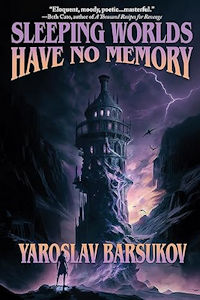Sleeping Worlds Have No Memory by Yaroslav Barsukov: Review by Paul Di Filippo
 Sleeping Worlds Have No Memory, Yaroslav Barsukov (CAEZIK SF & Fantasy 978-1647101367, trade paperback, 300pp, $19.99) November 2024
Sleeping Worlds Have No Memory, Yaroslav Barsukov (CAEZIK SF & Fantasy 978-1647101367, trade paperback, 300pp, $19.99) November 2024
Simply put, this is the most impressive debut novel I have encountered since Simon Jimenez’s The Vanished Birds. It actually has a lot of similarities to that previous exemplar. Not in subject matter—Birds was a postmodern space opera, while Memory is an almost New Weird science fantasy—but in terms of its particular employment of the fantastika toolkit; its themes, and its gravitas; and its deployment of a non-literal poetical title.
Moreover, the author, Barsukov, a native of Russia now living abroad, is one of those awe-inducing polyglots whose command of his adopted language, English, is superior to that of probably ninety percent of native speakers. I would jealously curse these geniuses such as Thomas Olde Heuvelt and Hannu Rajaniemi if they did not inspire all of us for whom English is the Mother Tongue to try to up our game.
Our protagonist, Shea Ashcroft, is an admirable young fellow of some complexity. At first, he seems deeply concerned with “merely” utilitarian matters. But as the book develops, his quest becomes increasingly ontological and cosmic.
Shea was something like a Minister of the Interior at the capitol of Red Hill, under Queen Daelyn. One day, riots broke out. Shea was given the order to use lethal gas to quell the rioters. He refused, and must now suffer the consequences of his actions, punishment that could be death or anything on down the scale.
Surprisingly and “mercifully,” Daelyn chooses to exile Shea to the borders of her empire, the small city of Owenbeg. There, the military is building an incredible tower. Overlooking the kingdom of Duma, the tower will be an unbreachable bastion for an upcoming inevitable war. Here is Shea’s first look from atop the unfinished tower:
The thin band at the horizon was the kingdom of Duma, with its perhaps less advanced but plentiful skyrafts; and his imagination painted a different sky, crimson, ships raining down in fireballs, the bolts from the tower’s ballistae hissing across the clouds. No wonder Daelyn had invested so much in the construction—it was her legacy, the most radical defensive structure ever attempted by man.
Shea gets the almost impossible job of shepherding the tower to completion. In this new capacity, he meets a host of intriguing characters. Brielle, the master engineer. The suspicious and vindictive Duke of Owenbeg, who resents Shea’s presence. The doddering Queen Mother and her silly pug dog. (A definite hint of Gormenghast here.). The Duke’s right hand man and assigned killer, Patrick. And most consequentially, Lena, the half-Drakiri mistress of the Duke.
The Drakiri are a separate race, origins unknown. Outcasts from some foreign land, they are bigger and stronger than baseline humans, and possess secret technologies in advance of ours. They reluctantly sell a device nicknamed the “tulip” for its shape. A tulip can produce local changes in gravity, and Brielle is using them to stabilize the tower. There’s only one problem: misused, a tulip can implode into a kind of temporary mini-black hole.
And tulips killed Shea’s beloved sister, who shares the name Lena with this striking woman at the Duke’s court.
Soon, Shea is outwitting assassins, surveying constructions methods—and taking the glamorous Drakiri Lena to bed. They become deeply enamored lovers out of sight of the Duke. As one might expect, this is not going to end well.
But before their affair does culminate in disaster, Shea learns astonishing things from his Drakiri girlfriend. If the Owenbeg tower is ever completed, it will open up an interdimensional rift, exposing the hideous Mimic Tower, and bring doom to the whole world.
The rest of the book consists of Shea’s harrowing and awesome and unpredictable journey, into Duma and beyond, in an attempt to save his world.
The first thing to note about Shea and about Barsukov’s approach to his tale is Shea’s interiority. We are privy to much of his unspoken thoughts, and he himself is burdened by his sensitivity and self-consciousness, approaching Hamlet magnitude. This is not traditionally the type of character at the heart of adventure-centric fantastika. I am reminded of M. John Harrison’s Kefahuchi Tract Trilogy. And like Harrison’s work, Barsukov’s novel shares a fascination with the quotidian: the play of light across common objects, the lives of average citizens. This aspect is in perfect balance with the requisite fantastical elements, and it forms a synergy, each half of reality enhancing the other. Here’s Brielle fantasizing about exchanging her onerous tasks for the simple life:
Her favorite place was a deserted portal on the second level, a hundred and fifty feet above the ground. The artisans had made the opening too narrow by mistake, which in turn made it impractical to roll the ballista through. There was no wooden platform outside, and no people around. The portal overlooked a poplar-lined road that snaked across the countryside, sloped up the hill, and disappeared; Brielle liked to imagine at the other end was a small town in which she’d designed every building. At daytime, the road remained in shadow, but evenings cast it in reddish brown. The Copper Road, she called it in her mind. She’d even done a few design sketches: a one-story house, a tavern, a bookstore.
Other resonant works include John Ford’s unfinished novel Aspects, and Josiah Bancroft’s Books of Babel series. But I hope I may allude to one final cousin to Memory, without giving away Memory’s Big Reveal, and that is Paul Park’s A Princess of Roumania mythos. Like Park, Barsukov has no problem pushing his brain child to the edge of extinction and further.
The book’s brilliantly crafted ending is genuinely homely and charming and whimsical, a respite after so much travail. And it is utterly true to what has come before. This unusual segue from the heights of fantastika to the mortal plane provides a Tolkienesque note that affirms Barsukov’s ambition and grasp.
Interested in this title? Your purchase through the links below brings us a small amount of affiliate income and helps us keep doing all the reviews you love to read!
 While you are here, please take a moment to support Locus with a one-time or recurring donation. We rely on reader donations to keep the magazine and site going, and would like to keep the site paywall free, but WE NEED YOUR FINANCIAL SUPPORT to continue quality coverage of the science fiction and fantasy field.
While you are here, please take a moment to support Locus with a one-time or recurring donation. We rely on reader donations to keep the magazine and site going, and would like to keep the site paywall free, but WE NEED YOUR FINANCIAL SUPPORT to continue quality coverage of the science fiction and fantasy field.
©Locus Magazine. Copyrighted material may not be republished without permission of LSFF.






